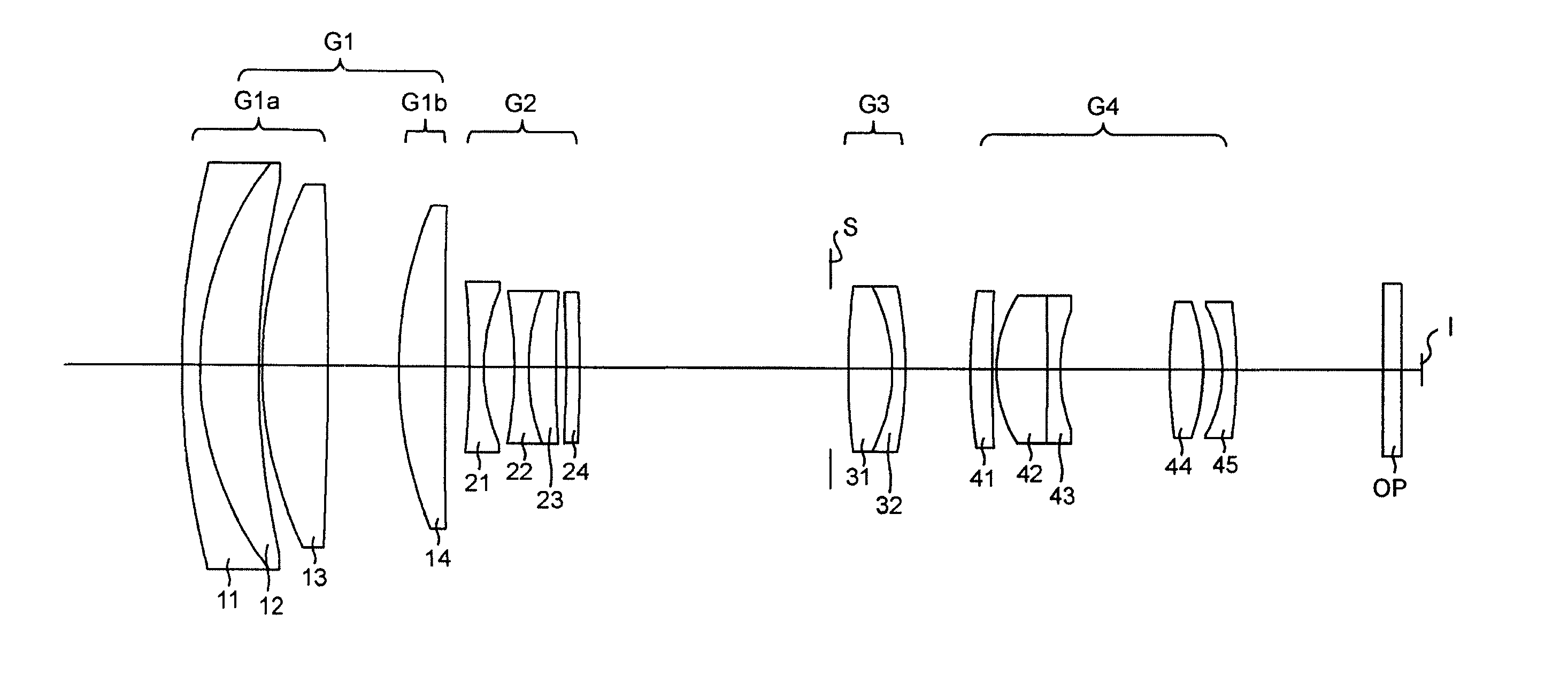Zoom lens system
a zoom lens and lens group technology, applied in the field of zoom lens systems, can solve the problems of unfavorable large size and weight of the entire zoom lens system, and achieve the effect of reducing the weight of the focusing lens group, short minimum photographing distance, and rapid and silent focusing operation
- Summary
- Abstract
- Description
- Claims
- Application Information
AI Technical Summary
Benefits of technology
Problems solved by technology
Method used
Image
Examples
first embodiment
[0076]As shown in the zoom path of FIG. 43, the zoom lens system of the first embodiment is configured of a positive first lens group (specified lens group) G1, a negative second lens group G2, a positive third lens group G3, and a positive fourth lens group G4, in that order from the object side. The first lens group G1 is configured of a positive first sub-lens group G1a and a positive second sub-lens group (focusing lens group) G1b, in that order from the object side. A diaphragm S which is provided between the second lens group G2 and the third lens group G3 moves integrally with the third lens group G3 in the optical axis direction. “I” designates the image plane.
[0077]In the zoom lens system of the first embodiment, upon zooming from the short focal length extremity (Wide) to the long focal length extremity (Tele), the distance between the first lens group G1 and the second lens group G2 increases, the distance between the second lens group G2 and the third lens group G3 decre...
second embodiment
[0094]As shown in the zoom path of FIG. 45, the zoom lens system of the second embodiment is configured of a negative first lens group (specified lens group) G1′ and a positive second lens group G2′, in that order from the object side. The first lens group G1′ is configured of a negative first sub-lens group G1a′ and a positive second sub-lens group (focusing lens group) G1b′ in that order from the object side. A diaphragm S which is provided between the first lens group G1′ and the second lens group G2′ moves integrally with the second lens group G2 in the optical axis direction. “I” designates the image plane.
[0095]The zoom lens system of the second embodiment, upon zooming from the short focal length extremity (Wide) to the long focal length extremity (Tele), the distance between the first lens group G1′ and the second lens group G2′ decreases. Upon zooming from the short focal length extremity to the long focal length extremity, the distance between the first sub-lens group G1a′...
numerical embodiment 1
[0108]FIGS. 1 through 13D and Tables 1 through 6 show a first numerical embodiment according to the present invention. FIG. 1 shows a lens arrangement of the zoom lens system when focusing on an object at infinity at the short focal length extremity. FIGS. 2A, 2B, 2C and 2D show various aberrations that occurred in the zoom lens system of FIG. 1 at the short focal length extremity when focused on an object at infinity. FIGS. 3A, 3B, 3C and 3D show various aberrations that occurred in the lens arrangement shown in FIG. 1 at an intermediate focal length when focused on an object at infinity. FIGS. 4A, 4B, 4C and 4D show various aberrations that occurred in the lens arrangement shown in FIG. 1 at the long focal length extremity when focused on an object at infinity. FIGS. 5A, 5B, 5C and 5D show various aberrations that occurred in the zoom lens system of FIG. 1 at the short focal length extremity at a predetermined photographing distance (0.75 m) of a normal photography mode. FIGS. 6A,...
PUM
 Login to View More
Login to View More Abstract
Description
Claims
Application Information
 Login to View More
Login to View More - R&D
- Intellectual Property
- Life Sciences
- Materials
- Tech Scout
- Unparalleled Data Quality
- Higher Quality Content
- 60% Fewer Hallucinations
Browse by: Latest US Patents, China's latest patents, Technical Efficacy Thesaurus, Application Domain, Technology Topic, Popular Technical Reports.
© 2025 PatSnap. All rights reserved.Legal|Privacy policy|Modern Slavery Act Transparency Statement|Sitemap|About US| Contact US: help@patsnap.com



